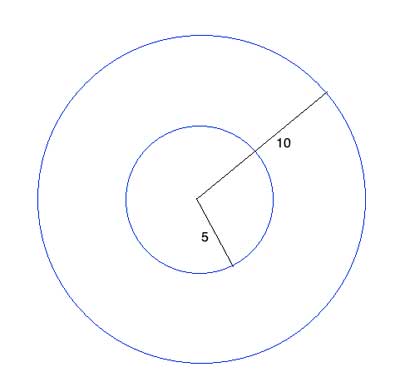The formula for the area of a circle is Acircle=π*r2

"π" is a special number, which is the same for all circles, and is the ratio between a circle's diameter and its circumference.
The formula is pretty simple, so most problems involving finding the area of a circle will be straightforward, and will require either using a given radius length or finding the radius using other information given in the problem. For example, we can use the formula to find the area of a semicircle or its perimeter.
Problem
A washer has an outside diameter of 10 units and an inside diameter of 5 units. How much smaller is the area of the inner circle, compared to the outer circle?

Strategy
We will solve this using the simple formula for the area of a circle, after we get the length of the radius from the given diameter. Then we will see how this can be generalized, so that the answer can be found without calculating the area of either circle.
Solution
(1) router= ½Douter //Radius is half the diameter
(2) Douter = 10 //Given
(3) router= 5 //(1), (2)
(4) Aouter=π*router2 //Area of a circle
(5) Aouter=π*52= 25π
(6) rinner= ½Dinner //Radius is half the diameter
(7) Dinner = 5 //Given
(8) Rinner= 2.5 //(6), (7)
(9) Ainner=π*rinner2 //Area of a circle
(10) Ainner=π*2.52= 6.25π
(11) Ainner/Aouter=6.25π/25π=6.25/25=¼
So, the inner circle's area is ¼ of the outer one. It is interesting to note that π does not factor into this at all. So let's try to generalize this, using just symbols, instead of solving with numbers:
Ainner=π*rinner2
Aouter=π*router2
Ainner/Aouter = π*rinner2/π*router2
Ainner/Aouter = rinner2/router2 = (rinner/router)2
And we can see that in general, the ratio between the areas is the square of the ratio of the radii, so if we halved the diameter (as in the problem above), the area of the smaller circle will be ¼ of the larger one, without having to calculate either area.
